Ornithology Test 2
Migration and Navigation Lecture
Why migrate?- food/hormones (survival, reproduction)
Alternatives?- caching, slowing metabolism, continuing to forage
Why not Migrate?- saves energy
How do birds prepare for migration?
annual cycles
feathers molted- makes sure they’re in good shape
eat foods with high fat/sugar
Changes in body mass (bulking season ong)
Hyperphagia
Nutritional content
3-5% summer, 30-47% premigration
organ and muscle use (decrease in mass)
North American Flyaways
5 billion birds, 200 species
Neotropical migrants
(Atlantic, Mississippi, Central, Pacific paths)
Stopovers
used to feed and refill (gas stations for birds)
ex: Delaware Bay- shorebirds eating horseshoe crab eggs
Artic Tern
12,000 km (9000 mi)
breed in the Artic and go to Antarctica in the winter
Bar-tailed Godwits
Alaska to Australia
How do we track migration?
banding
GPS
Radar
Stable Isotopes
Audio Recording
Reporting Observations
How do birds navigate?
Relocation experiments
ex: white-crowned sparrows
ways:
Visual landmarks
sun compass
star compass
geomagnetism
odors
twilight angles
learning
How does migration affect conservation?
breeding grounds
wintering grounds
stopovers
Lecture- Mating
Dioecious- 2 sexes
dimorphism- Different look, color, and sizes
Dichromatism- 2 different plumage colors (males- bright females-dull)
Anisogamy- 2 different sizes of gametes and different levels of production of gametes
millions of sperm vs 1 egg take the same amount of energy
more energy needed to make egg
Sexual selection-
what might birds use to select mates?
plumage and vocalization
Good genes and runaway selection
Runaway selection: trait becomes maladaptive (more risks of predators or death)
ex: winter wren, peacocks, antlers on deer
Displaying and lekking:
lekking- go to certain location and display
usually a bunch of birds displaying in one location
Why lekking?
hot spot- lots of birds there (rick’s fr)
hot shot- dominant male will get you the hoes
female preference- females want safety from predators and resources (picking up a baddie at a grocery store)
ex: blue manakin
Bowerbirds
male birds making a structure to show off
Territoriality
How does territoriality affect mating?
female wants male with good resources and territory
Gradient of polygamy- male mates with multiple females
some males have no breeding success
Courting and coupling
why go through courtship?
don’t want a random bird (need the best of the best)
birds go through courting period
Mate fidelity
Mating for life
raptors and geese
Monogamy vs Polygamy
Polygamy- multiple mates
most species show polygamy
Extra-pair Copulations: multiple males per clutch
Lecture- Copulation
Male-ZZ Females-ZW
Sex Hormones- know full word
LHRH (GnRH)
FSH
LH
Testosterone
Effects of Testosterone and Estrogen
Appearance
Behavior
Reproductive Organs
seasonal growth
Asymmetry (left ovary- active and produces egg) (right ovary- inactive)
Copulation
Cloacal kiss (DISGUSTINGGG)
hit and quit (lil quickie)
Male birds- cloacal protuberance
swelling
Ruddy duck- phallic organ (bruh it looks like a corkscrew but the hoes love it)
Sperm competition- different ways for males to compete with sperm
sperm ejection
200 million to 8 billion sperm in one ejaculation
ex: Dunnock- pecking at cloaca to remove sperm
ex: copulatory plug- drying agent that closes cloaca to prevent sperm ejection
Ovulation and fertilization
ovulation- release of ovum
occurs near INFUNDIBULUM
sperm storage
ruptured follicle become corpus luteum
corpus luteum- helps prepare for pregnancy
Egg Development
albumen- egg whites
egg yolk- nutrition/food
Completed eggs
chalaza- provides stabilization for middle portion
know the other parts
Effects of pesticides
DDT and DDE
killing the birds because birds were eating poisoned insects
caused brittle egg shells
no calcium deposits or vitamin D
Laying Sequence
Depends on time of development
Timing of incubation
Clutch Size
Synchronous vs Asynchronous hatching
Synchronous- develop at the same time
Asynchronous- develop as soon as they are laid and get incubated (don’t develop at the same time)
Embryo Development
Yolk (nutrition)- attached to abdomen
KNOW PARTS (chorion, albumen, amnion, allantoic sac, etc)
chick can communicate in the egg (via air cell)
What factors lead to breeding?
MAIN ONE: Photoperiodism
air temperature
rainfall
food
social interactions
Lecture- Nesting
what are the purposes of nests?
insulation, protects from predators, prevents eggs from rolling
variety of nests
bowl/cup nests- straw and soft grasses and sticks
EYRIE NEST- raptor nest used year after year with large sticks
hanging nest- vireo hanging nests on trees (mud, saliva, webs, etc)
Weever nests- weevers placing grass with tight knit walls
Floating nests- grebes use mats of floating vegetation
platform nests- coots build their own islands to make a platform
swift nests- cliff swallows use mud packed to make a nest
saliva nests- swiftlets use saliva to make a cup in a cave
natural cavity nests- using cavities
gila woodpeckers and small owl species use cacti
Turkey nests- ground exposed nest (no adult incubating? vulnerable nest)
hyperphagia often occurs before nesting (adults don’t have time to eat)
duck nests- ground nests near water surrounded by thick vegetation
smell can attract predators
BRUSH TURKEY or MOUND BUILDERS- use compost on top of eggs by piling on top of eggs to incubate them (leave nest- no parental care)
Burrowing owl nests- using burrows
Cavity within muddy banks- bank swallows
Murre- cliff nesters lay eggs directly on cliff (pointed eggs prevent rolling)
Nest construction:
grass plant material
cotton fluff
mud
feathers (eider down)
moss
sticks
hair from mammals or dead animals
human trash
Clutch- group of eggs
Brood- hatched eggs
Double Crested Cormorants- use dead trees for location of stick nests
Social weavers- social species build nests together (community)
Nest Sanitation- prevents smells and parasites
fecal sacs- chicks produce protein structure and adults remove it or eat it (tasty)
fecal projection- project poo poo (air strikes bomb them, keep bombing them)
Incubation effort
37% female only, 6% male only
shifts last from 1-2 hours to a month or more
Brood patch
patch that makes contact with the egg
lost feathers and use direct contact
can be used to identify whether a female has chicks or not during mist netting
Turning eggs
turning/rolling the egg over and moving eggs around to thoroughly provide warmth (rotisserie chicken style)
Incubation and development
temperature (36-41 degrees C)
Water retention
Candling- holding a light on egg to see development of egg
Hatching
Air cell- chick breaks into air cell and then cracks through egg shell
Egg tooth- hard piece of keratin used to crack cell
Birds can eat shell for calcium
What causes a nest to fail?
#1 cause: predation
Starvation- not enough food
Desertion- adults feel risk and may leave to survive
Hatching failure- bad development
Adverse weather- i.e. snow storms
What factors influence nest success?
nest success- chick fledges or chicks hatch
need right temperature and good incubation period
good nest with good location and materials
experience- more success with experienced parents
luck
enough food
right time of the year
Lecture- Growth and Development
Altricial vs Precocial
precocial- more independent and ready to go
eyes open, feathers, stand up earlier, walk/swim after hatching
strong legs
altricial- more care, time, and protection till independence
Egg size and Yolk size
altricial- SMALLER egg and LESS yolk
Ground nesters- more precocial (on ground, better be ready to go)
Passerines- more altricial (need to be better at flying)
KNOW CHART
Brain size- precocial have bigger brains at time of hatching
Small intestine- Altricial have larger small intestines
a lot of growing to do, so need more surface area to absorb food
Growth rate-
Altricial need to grow faster
Precocial- slower
fledglings often bigger than parents
Thermoregulation
feathers- natal down feathers
brooding- warmth obtained from baby birds huddling together
Why is independence important for nest success?
baby birds are vulnerable and need to grow up
adults want to take care of themselves again
quicker fledging means less vulnerability sooner
Nutrition
feather and bone growth- need to gain more protein
ie hummingbirds eating spiders
fat deposit
muscle growth
crop milk
Why would chicks be larger than adults
larger chick- more chance of survival
Begging
more noise- more food
noisiest chick- gets fed more (competition)
risk?- predators may be attracted to nest
benefits?- more food
Yellow bright mouths- serve as a target to help adult see mouths
Sibling competition-
Asynchronous laying- more competition
Yolk provision- last egg has more yolk than previous egg
Testosterone provision- increase growth rate/aggression/begging for the later eggs
yolk and testosterone provision- catches later eggs up to earlier hatched eggs
Siblicide- siblings abuse the last chick
Leaving the nest
nestling- bird in a nest
fledgling- bird that has left the nest
Altricial vs. precocial- determines time of fledging
Mortality (i.e. cavity ducks falling from tree cavity)
Development of skills and knowledge
nature vs. nurture?- both
innate behavior reinforced by experience
food soliciting- innate
predator avoidance- birds have to learn this
Imprinting
critical learning period- have to learn behavior (do this on adults)
chicks will imprint on people (in lab settings, chicks will sometimes think they are humans)
gotta learn who they are and what species they are
movement and sound
look for this and queue on
recognizing individuals
adults can recognize their chicks
chicks can recognize their adults
What chatgpt says: imprinting- involves the young animal recognizing and bonding with the first moving object it encounters, usually its parent or a surrogate caregiver. This process is crucial for the young animal's survival and development, as it helps them learn important behaviors, such as social interactions, communication, and foraging skills, from their caregiver.
Development of Assortative Mating
chicks look for mates that look like their parents
i.e. snow geese (white parents- chick wants white mate, vice versa for gray)
What are brood parasites?- rely on other species to take care of their young
cowbird- obligate brood parasite
innate chatter call
chicks grow up with a different species
don’t become attracted to the nest species tho
aggressive and will outcompete other siblings
Learning Life Skills
foraging
migrating
vocalizing
parent-offspring conflict
i.e. peregrine falcon
Lecture- Parental Care and Reproductive Success
Roles of a parent
brooding- protect a chick in nest
feeding
protecting
teaching
What are the costs of raising young?
fitness
stress
predation risk
how does a bird manage their costs?
mating effort- may put less effort if it isn’t his sperm (YOU ARE NOT THE FATHER)
Nesting Favoritism- adults feel like they can’t raise all so they favor the yapping ones
sex ratio- stressed bird puts more testosterone into the egg and changes the sex of eggs to male
Brood reduction- ignoring/kicking a chick out to have more success
desertion- really stressed, low fitness bird may abandon chicks
Life History
what is life history?- the series of events from birth through reproduction and eventually death that characterizes the life of an organism
what are different life history strategies?
R-selected- high fecundity and low parental investment
early reproductive maturity
high reproductive rate
short life expectancy
K-selected- low fecundity and high parental investment
delayed reproductive maturity
low reproductive rate
long life expectancy
what are the costs and benefits of each?
R-selected-
benefits: high reproductive rate, fast population growth, low parental investment
costs: high mortality rate, short life span, vulnerable to environmental variation (natural disasters)
K-selected-
benefits: high survivorship, long lifespan,
costs: low reproductive rate, delayed maturity, high parental investment
Fecundity- production of offspring (reproduction of eggs)
Life History
Juvenile mortality- higher in r-selected
age of first breeding- k-selected takes them longer
fecundity- # of chicks/eggs produced (high fecundity- large clutch size)
Adult mortality- k-selected is lower
Fast-slow axis- relative terms (species may be k-selected to some species or r-selected to others)
Life Tables-
Sx: survivorship for age class
Lx: Probability of survival of this age class from fledging
Bx: (Sx * Lx) number of female offspring per female subject
Age-Specific Fecundity
LBx: (Lx * Bx) Summation of LBx= the population replacement rate (Ro)
Greater than 1: sustaining
Less than 1: not sustaining
KNOW HOW TO DO THE MATH
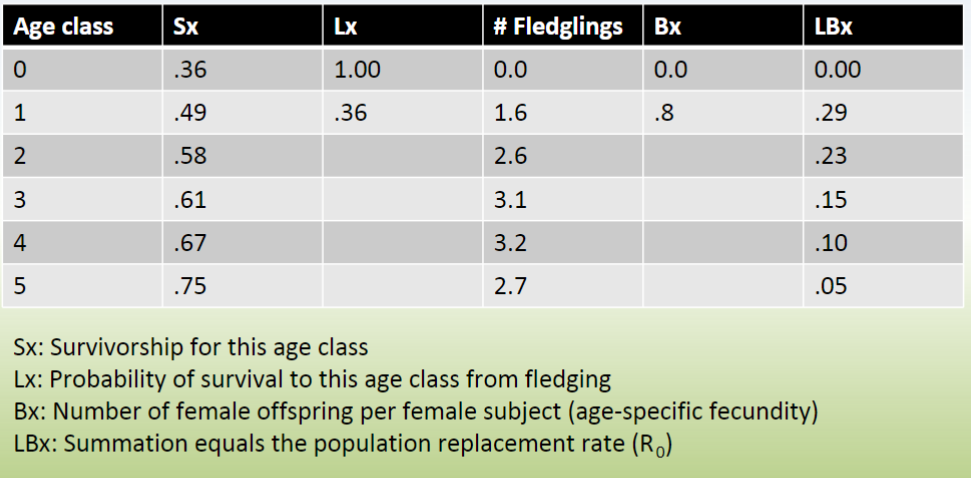
Lifespans
what are the advantages and disadvantages?
R: short lived- hope you don’t die first or have bad conditions before reproducing
K: bad year? not a big deal
ex: Albatross- 67 years old named Wisdom that got hella babies
Survivorship
R-selected: low survivorship in youth (losing over 80% of offspring)
Cooperative Breeders: yearlings help raise next clutch
Fecundity- # of chicks produced
nestling mass is small- more likely to double brood
high food availability- more likely to double brood
things to consider: probability of double brooding, food availability, nestling mass
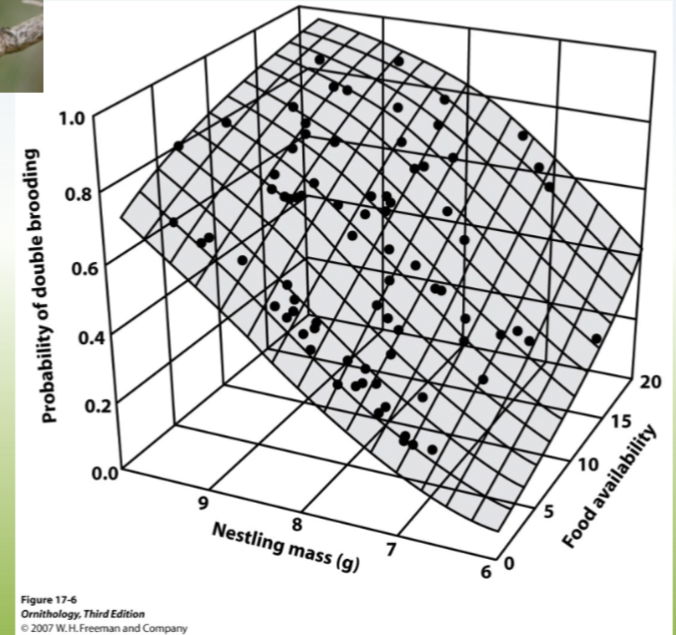
Age of Maturity-
why delay?- more wisdom, can learn more
sexual maturity
foraging skills
behavioral skills
territoriality and mortality- can’t breed until higher up on the pyramid
What affects annual reproductive effort?
food availability
predation
weather
previous effort- more effort from one clutch one year causes a smaller clutch next time so parents can recover
adult age
stress
adult sex
What determines clutch size
size of clutch increases as latitude increases
gets away from equator
seasons are shorter, have less time before conditions change
predation: less predation away from equator
a lot of predators in the tropics
predation increases, clutch size decreases
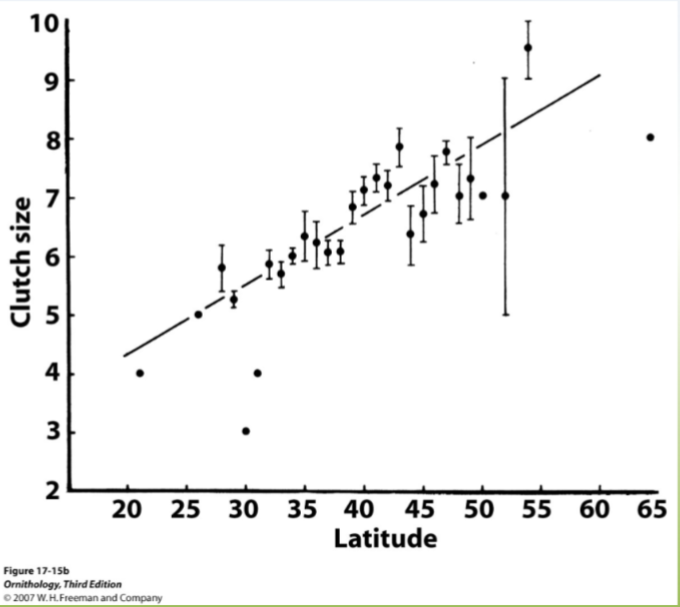
Why would reduced clutch size reduce predation?
less chicks, quicker time to get them out of there and out of harm
Lacks’ Food Limitation Hypothesis
clutch size is impacted by food availability
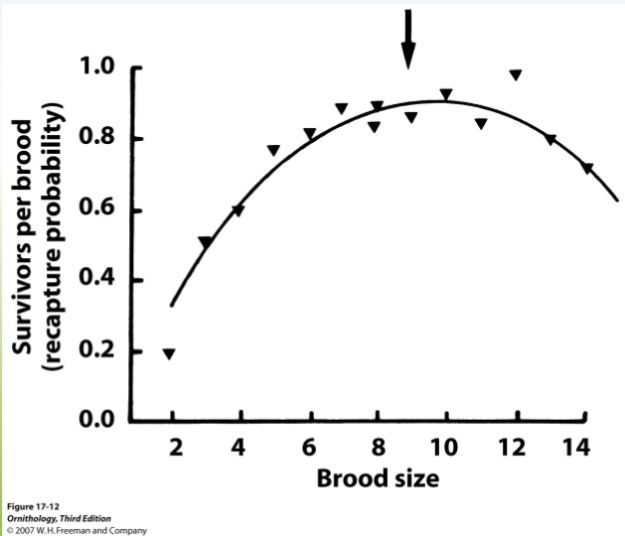
Survivorship Curves:
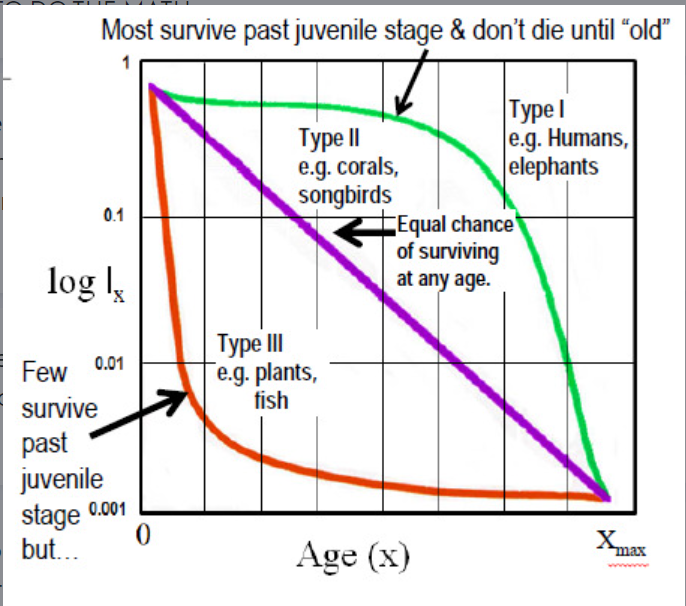
Type 1: (strongly convex)- high survival rate throughout lifespan; most mortality at end of life
Usually few offsprings and lots of parental care (humans, large mammals)
Type 2: (straight)- survival rates do not vary much with age, constant decay in survivorship (small birds, reptiles, rodents, perennial plants)
Type 3: (concave)- high mortality very early in life
Usually a lot of offspring, little or no parental care (oysters, fish, invertebrates)
Lecture- Food and Foraging
what do birds eat?
seeds/fruit- easily dispersed (soft mast)
acorns- (hard mast)
insects (larval stages/caterpillars)
aerial insectivore- catching insects in air
foraging for insects on vegetation or on other mammals
carnivores- fish, small mammals, amphibians, other birds (will also eat insects)
scavengers- carrion
birds will also eat a variety of food groups during different seasons (i.e fruit during fall, acorns in winter, insects in summer, etc)
odd example: vampire finch (finch love eating some boobies and boob blood fr)
other food sources:
eggs
leaves
soil- eating for calcium
nectar
sap
plastic?- birds eating this- leads to death or malnutrition
special adaptations: feet and bills
i.e. bald eagles using feet to hold food while using bill to pull the food
i.e. crossbill finch- has a cross bill that is used to eat pine seeds (eat clay to digest resin)
Specialist vs Generalist
specialist-has a narrow dietary niche and typically consumes a specific type of food or a limited range of food items.
negatively impacted if food source is no longer available
generalist-has a broad dietary niche and can consume a wide variety of different food types or food items.
how much do birds eat?
weight: 10 g 100g 1000g
eats: 3.5 g 10g 40g
% 35% 10% 4%
smaller birds: higher metabolism, need more food (SA:V)
Food choices
how do birds decide what to eat? most reward for minimal risk
Abundance vs. Availability
Abundance- how much is there
Availability- can they actually get to that food (predators, risks, blockages, etc.)
Search Image
takes a second to register something as food (takes time to switch from food type A to food type B)
Balanced Diet- one food type does not satisfy all nutritional needs
Feeding efficiency
two things to consider
nutritional content
handling time
Optimal foraging
clumped, uniform, random
traplining- move from flower to flower and then circle back again
feeding in groups-
multiple species have different strategies (efficient and increases survival)
attraction to other birds
why not forage optimally?
predation (not going to sit at a bird feeder all day and let the opps see you)
need other food sources
Niche partitioning
same food sources and same size? (i.e. owls and hawks)- hunt at different times of day
Temporal partitioning- feeding at different times
When do energy demands change?
hyperphagia- more food needed before nesting and migration
fat deposits- thick yellow mass of fat shows hyperphagia
Caching- storing food for later
Cycles in abundance of food
cycles can be seasonal or annual
impacts abundance of the “hunter”
Annual cycles
migration- food availability is a migration driver
laying eggs/hatching- done when food is available
ultimate vs. proximate factors
what is the most powerful proximate factor? photoperiod
what is the most powerful ultimate factor? survival and reproduction